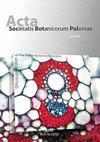希腊克里特岛一新种大毛茛(毛茛科,毛茛亚科)的分类和系统发育关系
IF 0.8
4区 生物学
Q3 PLANT SCIENCES
引用次数: 0
摘要
希腊克里特岛西部Lefka Ori山脉Omalos高原季节性湖泊中发现一新种——毛茛(Ranunculus dahlgreniae)。异叶物种类似于R. saniculifolius, R. peltatus和R. baudotii的地中海形式。它与上述物种的不同之处在于它们中没有发现的特征的组合,即,5-6毫米长的花瓣,最长可达2.2毫米长,无毛瘦果,部分宿存花柱,密被短柔毛,在果中略有拉长的花托,中间叶具有刚性丝状顶端裂片,分为两个或三个楔形,短叶柄的小叶。提出了所有类似东地中海分类群的钥匙。基于核、核糖体内部转录间隔区(ITS)和两个叶绿体非编码区(rpl32-trnL和psbE-petL)测序的DNA分析,加上双酶切RAD测序(ddRADseq)的全基因组多态性分析,支持大毛茛是一个独特的谱系,与R. peltatus、R. baudotii和R. saniculifolius明显分离。基于ddRADseq的系统发育类似于从叶绿体和nrITS数据中获得的拓扑结构,但分辨率和精细尺度关系的支持增加了。广泛的取样,包括来自温带欧洲和西地中海地区的分类群,以及减少代表性测序的应用,可以更好地了解Batrachium剖面的多样性模式。本文章由计算机程序翻译,如有差异,请以英文原文为准。
Ranunculus dahlgreniae (section Batrachium, Ranunculaceae), a new species from Crete, Greece, with remarks on taxonomy and phylogenetic relations within the section
A new species, Ranunculus dahlgreniae, is described from a seasonal lake at Omalos Plateau, Lefka Ori Mountains, western Crete, Greece. The heterophyllous species resembles R. saniculifolius, R. peltatus, and the Mediterranean forms of R. baudotii. It differs from the aforementioned species by a combination of characters not found in any of them, i.e., 5–6 mm long petals, up to 2.2 mm long, glabrous achenes with a partly persistent style, a densely pubescent, in fruit slightly elongating receptacle, and intermediate leaves with rigid filiform apical segments, being divided into two or three cuneate, shortly petiolate leaflets. A key to all similar East Mediterranean taxa is presented. DNA analyses based on the sequencing of nuclear, ribosomal Internal Transcribed Spacer (ITS), and two chloroplast noncoding regions (rpl32-trnL and psbE-petL), complemented by the analysis of genome-wide polymorphism using double digest RAD Sequencing (ddRADseq) supported that Ranunculus dahlgreniae is a distinct lineage, clearly separated from R. peltatus, R. baudotii, and R. saniculifolius. The phylogeny based on ddRADseq resembles the topologies obtained from chloroplast and nrITS data but with increasing resolution and support of fine-scale relationships. Extensive sampling, including taxa from temperate Europe and the West Mediterranean area, as well as the application of reduced-representation sequencing, allowed to better
understand the pattern of diversity in the section Batrachium.
求助全文
通过发布文献求助,成功后即可免费获取论文全文。
去求助
来源期刊
CiteScore
2.00
自引率
10.00%
发文量
18
审稿时长
1 months
期刊介绍:
The journal has been published since 1923 and offers Open Access publication of original research papers, short communications, and reviews in all areas of plant science, including evolution, ecology, genetics, plant structure and development, physiology and biochemistry.

 求助内容:
求助内容: 应助结果提醒方式:
应助结果提醒方式:


